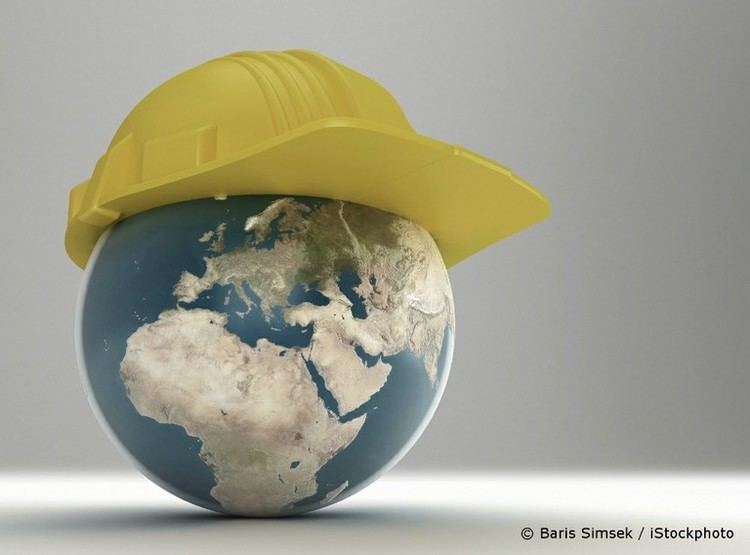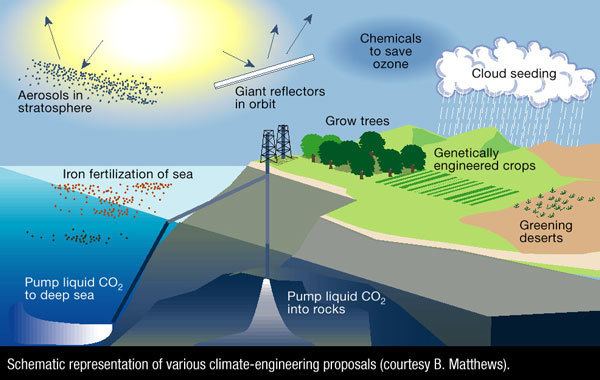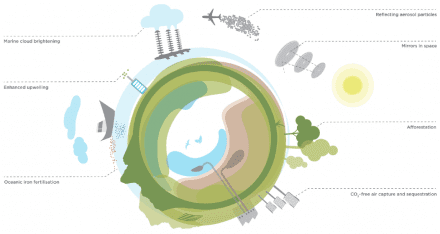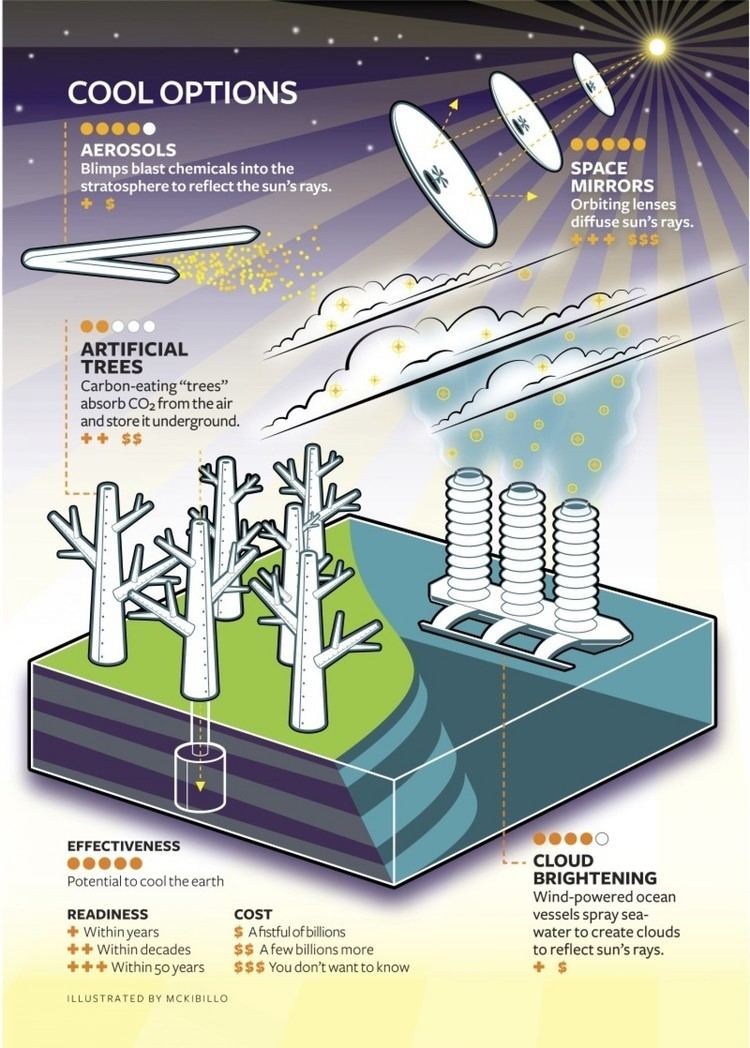 | ||
Climate engineering, commonly referred to as geoengineering, also known as climate intervention, is the deliberate and large-scale intervention in the Earth’s climatic system with the aim of limiting adverse climate change. Climate engineering is an umbrella term for two types of measures: carbon dioxide removal and solar radiation management. Carbon dioxide removal addresses the cause of climate change by removing one of the greenhouse gases (carbon dioxide) from the atmosphere. Solar radiation management attempts to offset effects of greenhouse gases by causing the Earth to absorb less solar radiation.
Contents
- Climate engineering jesse reynolds at tedxtilburguniversity
- Background
- Proposed strategies
- Solar radiation management
- Carbon dioxide removal
- Tipping points and positive feedback
- Buying time
- Costs
- Ethics and responsibility
- Politics
- Risks and criticisms
- Ineffectiveness
- Moral hazard or risk compensation
- Governance
- Implementation issues
- Evaluation of climate engineering
- National Academy of Sciences
- Intergovernmental Panel on Climate Change
- References

Climate engineering approaches are sometimes viewed as additional potential options for limiting climate change, alongside mitigation and adaptation. There is substantial agreement among scientists that climate engineering cannot substitute for climate change mitigation. Some approaches might be used as accompanying measures to sharp cuts in greenhouse gas emissions. Given that all types of measures for addressing climate change have economic, political, or physical limitations, some climate engineering approaches might eventually be used as part of an ensemble of measures. Research on costs, benefits, and various types of risks of most climate engineering approaches is at an early stage and their understanding needs to improve to judge their adequacy and feasibility.

Almost all research into solar radiation management has consisted of computer modelling or laboratory tests, and an attempt to move to outdoor experimentation was controversial. Some carbon dioxide removal practices, such as planting of trees and bio-energy with carbon capture and storage projects, are underway. Their scalability to effectively affect global climate is, however, debated. Ocean iron fertilization has been given small-scale research trials, sparking substantial controversy.

Most experts and major reports advise against relying on climate engineering techniques as a simple solution to climate change, in part due to the large uncertainties over effectiveness and side effects. However, most experts also argue that the risks of such interventions must be seen in the context of risks of dangerous climate change. Interventions at large scale may run a greater risk of disrupting natural systems resulting in a dilemma that those approaches that could prove highly (cost-) effective in addressing extreme climate risk, might themselves cause substantial risk. Some have suggested that the concept of engineering the climate presents a so-called "moral hazard" because it could reduce political and public pressure for emissions reduction, which could exacerbate overall climate risks; others assert that the threat of climate engineering could spur emissions cuts. Groups such as ETC Group and some climate researchers (such as Raymond Pierrehumbert) are in favour of a moratorium on out-of-doors testing and deployment of solar radiation management (SRM).
Climate engineering jesse reynolds at tedxtilburguniversity
Background

With respect to climate, geoengineering is defined by the Royal Society as "... the deliberate large-scale intervention in the Earth’s climate system, in order to moderate global warming."

Several organizations have investigated climate engineering with a view to evaluating its potential, including the US Congress, the National Academy of Sciences, the Royal Society, and the UK Parliament. The Asilomar International Conference on Climate Intervention Technologies was convened to identify and develop risk reduction guidelines for climate intervention experimentation.

Some environmental organisations (such as Friends of the Earth and Greenpeace) have been reluctant to endorse solar radiation management, but are often more supportive of some carbon dioxide removal projects, such as afforestation and peatland restoration. Some authors have argued that any public support for climate engineering may weaken the fragile political consensus to reduce greenhouse gas emissions.
Proposed strategies

Several climate engineering strategies have been proposed. IPCC documents detail several notable proposals. These fall into two main categories: solar radiation management and carbon dioxide removal. Here is a list of specific proposals.
Solar radiation management
Solar radiation management (SRM) techniques would seek to reduce sunlight absorbed (ultra-violet, near infra-red and visible). This would be achieved by deflecting sunlight away from the Earth, or by increasing the reflectivity (albedo) of the atmosphere or the Earth's surface. These methods would not reduce greenhouse gas concentrations in the atmosphere, and thus would not seek to address problems such as the ocean acidification caused by CO2. In general, solar radiation management projects presently appear to be able to take effect rapidly and to have very low direct implementation costs relative to greenhouse gas emissions cuts and carbon dioxide removal. Furthermore, many proposed SRM methods would be reversible in their direct climatic effects. While greenhouse gas remediation offers a more comprehensive possible solution to climate change, it does not give instantaneous results; for that, solar radiation management is required.
Solar radiation management methods may include:
Carbon dioxide removal
Carbon dioxide removal (sometimes known as negative emissions technologies or greenhouse gas removal) projects seek to remove carbon dioxide from the atmosphere. Proposed methods include those that directly remove such gases from the atmosphere, as well as indirect methods that seek to promote natural processes that draw down and sequester CO2 (e.g. tree planting). Many projects overlap with carbon capture and storage projects, and may not be considered to be climate engineering by all commentators. Techniques in this category include:
Tipping points and positive feedback
It is argued that climate change may cross tipping points where elements of the climate system may 'tip' from one stable state to another stable state, much like a glass tipping over. When the new state is reached, further warming may be caused by positive feedback effects,. An example of a proposed causal chain leading to runaway global warming is the collapse of Arctic sea ice triggering subsequent release of methane. Such a scenario, however, is regarded as unlikely by many scientists.
The precise identity of such "tipping points" is not clear, with scientists taking differing views on whether specific systems are capable of "tipping" and the point at which this "tipping" will occur. An example of a previous tipping point is that which preceded the rapid warming leading up to the Paleocene–Eocene Thermal Maximum. Once a tipping point is crossed, cuts in anthropogenic greenhouse gas emissions will not be able to reverse the change. Conservation of resources and reduction of greenhouse emissions, used in conjunction with climate engineering, are therefore considered a viable option by some commentators.
Buying time
Climate engineering offers the hope of temporarily reversing some aspects of climate change and allowing the natural climate to be substantially preserved whilst greenhouse gas emissions are brought under control and removed from the atmosphere by natural or artificial processes.
Costs
Estimates of direct costs for climate engineering implementation vary widely. In general, carbon dioxide removal methods are more expensive than the solar radiation management ones. In their 2009 report Geoengineering the Climate the Royal Society judged afforestation and stratospheric aerosol injection as the methods with the "highest affordability" (lowest costs). More recently, research into costs of solar radiation management have been published. This suggests that "well designed systems" might be available for costs in the order of a few hundred million to tens of billions of dollars per year. These are much lower than costs to achieve comprehensive reductions in CO2 emissions. Such costs would be within the budget of most nations, and even some wealthy individuals.
Ethics and responsibility
Climate engineering would represent a large-scale, intentional effort to modify the climate. It would differ from activities such as burning fossil fuels, as they change the climate inadvertently. Intentional climate change is often viewed differently from a moral standpoint. It raises questions of whether humans have the right to change the climate deliberately, and under what conditions. For example, there may be an ethical distinction between climate engineering to minimize anthropogenic climate change and doing so to optimize the climate. Furthermore, ethical arguments often confront larger considerations of worldview, including individual and social religious commitments. This may imply that discussions of climate engineering should reflect on how religious commitments might influence the discourse. For many people, religious beliefs are pivotal in defining the role of human beings in the wider world. Some religious communities might claim that humans have no responsibility in managing the climate, instead seeing such world systems as the exclusive domain of a Creator. In contrast, other religious communities might see the human role as one of "stewardship" or benevolent management of the world. The question of ethics also relates to issues of policy decision-making. For example, the selection of a globally agreed target temperature is a significant problem in any climate engineering governance regime, as different countries or interest groups may seek different global temperatures.
Politics
It has been argued that regardless of the economic, scientific and technical aspects, the difficulty of achieving concerted political action on climate change requires other approaches. Those arguing political expediency say the difficulty of achieving meaningful emissions cuts and the effective failure of the Kyoto Protocol demonstrate the practical difficulties of achieving carbon dioxide emissions reduction by the agreement of the international community. However, others point to support for climate engineering proposals among think tanks with a history of climate change skepticism and opposition to emissions reductions as evidence that the prospect of climate engineering is itself already politicized and being promoted as part of an argument against the need for (and viability of) emissions reductions; that, rather than climate engineering being a solution to the difficulties of emissions reductions, the prospect of climate engineering is being used as part of an argument to stall emissions reductions in the first place.
Risks and criticisms
Various criticisms have been made of climate engineering, particularly solar radiation management (SRM) methods. Decision making suffers from intransitivity of policy choice. Some commentators appear fundamentally opposed. Groups such as ETC Group and individuals such as Raymond Pierrehumbert have called for a moratorium on climate engineering techniques.
Ineffectiveness
The effectiveness of the techniques proposed may fall short of predictions. In ocean iron fertilization, for example, the amount of carbon dioxide removed from the atmosphere may be much lower than predicted, as carbon taken up by plankton may be released back into the atmosphere from dead plankton, rather than being carried to the bottom of the sea and sequestered.
Moral hazard or risk compensation
The existence of such techniques may reduce the political and social impetus to reduce carbon emissions. This has generally been called a potential moral hazard, although risk compensation may be a more accurate term. This concern causes many environmental groups and campaigners to be reluctant to advocate or discuss climate engineering for fear of reducing the imperative to cut greenhouse gas emissions. However, several public opinion surveys and focus groups have found evidence of either assertions of a desire to increase emission cuts in the face of climate engineering, or of no effect. Other modelling work suggests that the threat of climate engineering may in fact increase the likelihood of emissions reduction.
Governance
Climate engineering opens up various political and economic issues. The governance issues characterizing carbon dioxide removal compared to solar radiation management tend to be distinct. Carbon dioxide removal techniques are typically slow to act, expensive, and entail risks that are relatively familiar, such as the risk of carbon dioxide leakage from underground storage formations. In contrast, solar radiation management methods are fast-acting, comparatively cheap, and involve novel and more significant risks such as regional climate disruptions. As a result of these differing characteristics, the key governance problem for carbon dioxide removal (as with emissions reductions) is making sure actors do enough of it (the so-called "free rider problem"), whereas the key governance issue for solar radiation management is making sure actors do not do too much (the "free driver" problem).
Domestic and international governance vary by the proposed climate engineering method. There is presently a lack of a universally agreed framework for the regulation of either climate engineering activity or research. The London Convention addresses some aspects of the law in relation to biomass ocean storage and ocean fertilization. Scientists at the Oxford Martin School at Oxford University have proposed a set of voluntary principles, which may guide climate engineering research. The short version of the 'Oxford Principles' is:
These principles have been endorsed by the House of Commons of the United Kingdom Science and Technology Select Committee on “The Regulation of Geoengineering”, and have been referred to by authors discussing the issue of governance.
The Asilomar conference was replicated to deal with the issue of climate engineering governance, and covered in a TV documentary, broadcast in Canada.
Implementation issues
There is general consensus that no climate engineering technique is currently sufficiently safe or effective to greatly reduce climate change risks, for the reasons listed above. However, some may be able to contribute to reducing climate risks within relatively short times.
All proposed solar radiation management techniques require implementation on a relatively large scale, in order to impact the Earth's climate. The least costly proposals are budgeted at tens of billions of US dollars annually. Space sunshades would cost far more. Who was to bear the substantial costs of some climate engineering techniques may be hard to agree. However, the more effective solar radiation management proposals currently appear to have low enough direct implementation costs that it would be in the interests of several single countries to implement them unilaterally.
In contrast, carbon dioxide removal, like greenhouse gas emissions reductions, have impacts proportional to their scale. These techniques would not be "implemented" in the same sense as solar radiation management ones.The problem structure of carbon dioxide removal resembles that of emissions cuts, in that both are somewhat expensive public goods, whose provision presents a collective action problem.
Before they are ready to be used, most techniques would require technical development processes that are not yet in place. As a result, many promising proposed climate engineering do not yet have the engineering development or experimental evidence to determine their feasibility or efficacy.
Evaluation of climate engineering
Most of what is known about the suggested techniques is based on laboratory experiments, observations of natural phenomena, and on computer modelling techniques. Some proposed climate engineering methods employ methods that have analogues in natural phenomena such as stratospheric sulfur aerosols and cloud condensation nuclei. As such, studies about the efficacy of these methods can draw on information already available from other research, such as that following the 1991 eruption of Mount Pinatubo. However, comparative evaluation of the relative merits of each technology is complicated, especially given modelling uncertainties and the early stage of engineering development of many proposed climate engineering methods .
Reports into climate engineering have also been published in the United Kingdom by the Institution of Mechanical Engineers and the Royal Society. The IMechE report examined a small subset of proposed methods (air capture, urban albedo and algal-based CO2 capture techniques), and its main conclusions were that climate engineering should be researched and trialled at the small scale alongside a wider decarbonisation of the economy.
The Royal Society review examined a wide range of proposed climate engineering methods and evaluated them in terms of effectiveness, affordability, timeliness and safety (assigning qualitative estimates in each assessment). The report divided proposed methods into "carbon dioxide removal" (CDR) and "solar radiation management" (SRM) approaches that respectively address longwave and shortwave radiation. The key recommendations of the report were that "Parties to the UNFCCC should make increased efforts towards mitigating and adapting to climate change, and in particular to agreeing to global emissions reductions", and that "[nothing] now known about climate engineering options gives any reason to diminish these efforts". Nonetheless, the report also recommended that "research and development of climate engineering options should be undertaken to investigate whether low risk methods can be made available if it becomes necessary to reduce the rate of warming this century".
In a 2009 review study, Lenton and Vaughan evaluated a range of proposed climate engineering techniques from those that sequester CO2 from the atmosphere and decrease longwave radiation trapping, to those that decrease the Earth's receipt of shortwave radiation. In order to permit a comparison of disparate techniques, they used a common evaluation for each technique based on its effect on net radiative forcing. As such, the review examined the scientific plausibility of proposed methods rather than the practical considerations such as engineering feasibility or economic cost. Lenton and Vaughan found that "[air] capture and storage shows the greatest potential, combined with afforestation, reforestation and bio-char production", and noted that "other suggestions that have received considerable media attention, in particular "ocean pipes" appear to be ineffective". They concluded that "[climate] geoengineering is best considered as a potential complement to the mitigation of CO2 emissions, rather than as an alternative to it".
In October 2011, a Bipartisan Policy Center panel issued a report urging immediate researching and testing in case "the climate system reaches a 'tipping point' and swift remedial action is required".
National Academy of Sciences
The National Academy of Sciences conducted a 21-month project to study the potential impacts, benefits, and costs of two different types of climate engineering: carbon dioxide removal and albedo modification (solar radiation management). The differences between these two classes of climate engineering "led the committee to evaluate the two types of approaches separately in companion reports, a distinction it hopes carries over to future scientific and policy discussions."
According to the two-volume study released in February 2015:
"Climate intervention is no substitute for reductions in carbon dioxide emissions and adaptation efforts aimed at reducing the negative consequences of climate change. However, as our planet enters a period of changing climate never before experienced in recorded human history, interest is growing in the potential for deliberate intervention in the climate system to counter climate change. ...Carbon dioxide removal strategies address a key driver of climate change, but research is needed to fully assess if any of these technologies could be appropriate for large-scale deployment. Albedo modification strategies could rapidly cool the planet’s surface but pose environmental and other risks that are not well understood and therefore should not be deployed at climate-altering scales; more research is needed to determine if albedo modification approaches could be viable in the future."
The project was sponsored by the National Academy of Sciences, U.S. Intelligence Community, National Oceanic and Atmospheric Administration, NASA, and U.S. Department of Energy.
Intergovernmental Panel on Climate Change
The Intergovernmental Panel on Climate Change (IPCC) assessed the scientific literature on climate engineering (referred to as "geoengineering" in its reports), in which it considered carbon dioxide removal and solar radiation separately. Its Fifth Assessment Report states:
Models consistently suggest that SRM would generally reduce climate differences compared to a world with elevated GHG concentrations and no SRM; however, there would also be residual regional differences in climate (e.g., temperature and rainfall) when compared to a climate without elevated GHGs....
Models suggest that if SRM methods were realizable they would be effective in countering increasing temperatures, and would be less, but still, effective in countering some other climate changes. SRM would not counter all effects of climate change, and all proposed geoengineering methods also carry risks and side effects. Additional consequences cannot yet be anticipated as the level of scientific understanding about both SRM and CDR is low. There are also many (political, ethical, and practical) issues involving geoengineering that are beyond the scope of this report.
